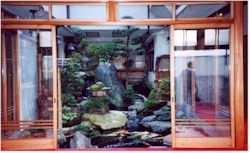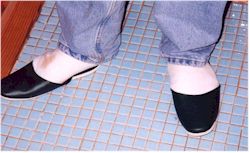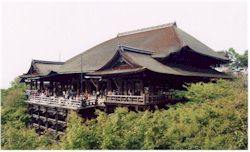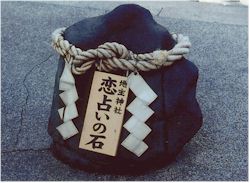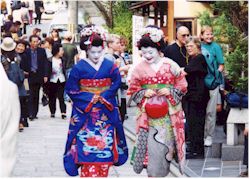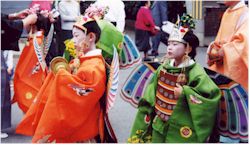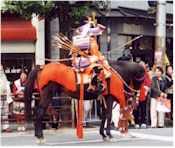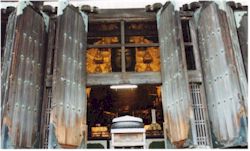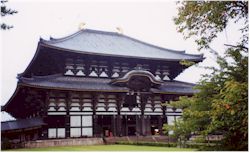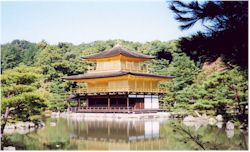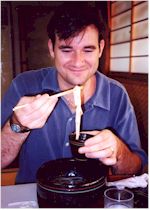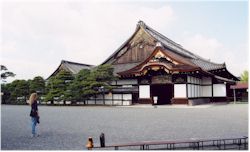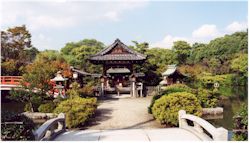|
Kyoto / Nara[links] |
October 21 - October 24, 2000 |
|
When we first arrived at Tokyo Station, some friendly people helped us find our exit and our way to the Imperial Hotel. But this little bit of friendliness was nothing compared to the helpfulness of one resident of Kyoto. I'll let Elaine explain it:
So, Utsonomiya-san, if you're out there, domo arigatoo gozaimasu! While we were walking around on the veranda, three young boys walked up to me and said, "Sree questons!" (that's "Three questions"). They asked where I was from, what was my favorite Japanese food, and what my favorite animal was. Elaine was next, getting the same questions from some little girls, except instead of animal, she was asked her favorite sport. After writing down their answers (in Japanese, naturally), they enthusiastically said "Sank you bery much, hab a nice day!". We thought they were horrendously cute. On the temple grounds is a shrine called Jishu Shrine (finally got images scanned in!), known for being the dwelling place of the god of love and matchmaking. There are stones there ("the love stones"), placed 30 feet apart. The story goes that if you can walk from one to the other with your eyes closed, your wish for love will come true. I got pictures of them, but somehow had slide film loaded...and I've yet to get them developed into photos. 7/17/01 - pictures on the right! We continued on our tour, taking in the sights of Kyoto, including Kodai-ji Temple with its famous Tea House, and Marayama Park, where Elaine got a soft-serve green tea ice cream cone. Next, we happened upon the Festival, which was taking the form of a
parade. We sat and the groups of people go by, each
group dressed in historical costume from different periods in Japanese history. Unfortunately, the signs preceding each group were in Kanji, so we couldn't really tell what periods came when. But seeing the various get-ups was quite thrilling. We ended the day eating at a restaurant with no English menus. One thing I've learned in Japan...if you can't read it, it's fish. Having a strong aversion to all things from the sea (including dried seaweed), I got to watch Elaine eat. We found some food for me back at Kyoto station. We decided that we should take a side trip to Nara the next day, to see the Daibutsu (the Bronze Buddha). That was an impressive sight. Nara itself was nice, and the Daibutsu is located in Nara Park, which is swarming with deer. They just wander around looking for handouts, with no fear. Todaiji Temple is the home of the Daibutsu. The construction of both the temple and the Daibutsu were ordered by Emperor Shomu in the mid-700s. The Daibutsu is housed by an enormous building called the Daibutsuden, which measures 161' tall, 187' long, and 164' wide. Add that to the fact that, having been destroyed and rebuilt more than once, it is now only two thirds its original size! The support beams in that place were like redwoods! The inside was just as impressive as the outside. The Buddha is 50 feet tall, and made of hundreds of tons of bronze, not to mention hundreds of pounds of pure gold. There are three statues in the hall, and they're all equally impressive. Walking back to the station (a mile or so), the rain picked up and we got pretty cold and soggy. When we arrived back in Kyoto, I took us to a restaurant I had seen earlier in the basement of Kyoto tower. It's a little Chinese place, and I highly recommend it, even though I have no idea what the name of it is.
Having taken a rainy day in Nara, we next took walking tour in Northern Kyoto, visiting Kinkakuji Temple, and Ryoanji Temple. Kin is the Japanese word for "gold", and Kinkakuji means "Golden Pavilion". The Temple of the Golden Pavilion is a stunningly beautiful building. It's a three story temple, entirely covered in gold leaf. Seeing it as we did, in full sun, was quite a thing.
Ryoanji Temple is best known for its Zen Rock Garden. Fifteen stones, perfectly placed in raked white pebbles, that are evidentally supposed to teach us much about life. Well, we didn't really learn much about it, but that's probably an East/West difference. But the garden was quite lovely, if not in a brightly colored or decorated way. On our way out, we had one of my favorite meals of the whole trip. We stopped at a very small restaurant and ordered bowls of Udon (thick white noodles). They came with small cups of warm soy sauce, along with ground ginger and sliced leeks. The process is simple...mix the sauce how you want it with the ginger and onion, then pull udon out of the bowl, dip them in the soy, and slurp away! And I mean SLURP! The Japanese are voracious slurpers when it comes to eating noodles. For the good mannered American boy, it was very liberating. Okay, so maybe I'm not that well mannered to begin with, but it was a convenient excuse to slurp loudly. Anyway, the noodles were absolutely delicious. Next, we came to Nijo-jo (Nijo Castle), on of the residence castles of Shogun Tokugawa Ieyasu (if you've read James Clavell's Shogun, that's "Toranaga" to you). Being a residence castle, it's not build like a fortress, on top of battlements and high walls. Instead, it was ground level, with a moat, of course, but the most fascinating security feature by far was the "Nightengale floor".
Unfortunately, we weren't allowed to photograph the interior of the castle. I would have loved to have a picture of one of those paintings of pines and eagles. Something cool on the tour was the numerous models of samurai and ladies-in-waiting, showing how the various rooms were utilized. Walking back toward the bus routes, we encountered a small garden right in the middle of a residential area. It was terribly quaint and pretty, so we had to take some pictures. We made a quick stop at the Kyoto Handicraft Center after wandering for far too long searching for it. After such a nice, productive day, wandering fruitlessly really put is in a non-buying mood. We saw many pretty things, but didn't elect to buy anything. One more thing I'd like to talk about...food. A distinctive feature of Japan is multi-level shopping malls. The ground floor is nearly always a grocery/deli area. We found some of our favorite food in these areas. It was always great to just walk through one, grab some chicken skewers and steamed rice, and get on the train. Also, at many of the train stations, there are little stall restaurants, including ones specializing in O-Bento (boxed lunches). The Bento boxes can really be convenient for train travel. Just check to see what's in it (normally rice, chicken/beef/fish, and pickled veggies), and buy the one you want. You'll also find O-Bento sold on the Shinkansen, as well as coffee, tea, and one of our favorite things...Pocky's! They're like pretzel sticks, dipped in chocolate. It was one of our little indulgences. Anyway.... We headed back to the hotel, grabbed our bags, and left for Okayama. Oh...one more interesting thing. I went to get some liquid refreshment from one of the many vending machines, and selected a can of lemon tea. It was HOT! That was a new experience for us. Naturally, I saved it for later and got a couple of cold selections. Stick around and look at the rest of the pictures if you haven't already, or continue the ride: On a rail...to Okayama.... Kyoto/Nara Links: [ Main Page ] |
|||
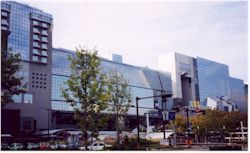
Kyoto station, clearly the most modern station we saw. The inside is equally impressive, right down to the Star Trek theme music. |
|||
|
Our little ryokan. It was a fantastic experience, right down to the public baths, futons, and green tea. |
|||
|
"One size fits all" does not include size 11 feet, evidentally. My heel stuck out about three inches from the back of them. |
|||
|
Kiyomizu Temple's most famous feature is the veranda, held up by 139 pillars, each 49 feet high. |
|||
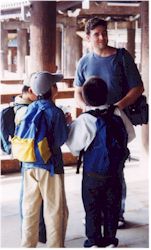
While wandering the veranda, Seth is pelted with questions from Japanese kids, apparently working on a school project. |
|||
|
These stones are known as the "Love Stones". The story is...if you can touch the first one (above), close your eyes, and walk to the other (below), your wish for love will come true. |
|||
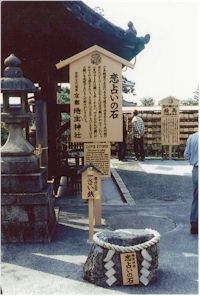 |
|||
|
These ladies were just too perfect to let by without a picture. We presume they were headed for the festival, where we saw many more like them. They just looked like porcelein dolls! |
|||
|
These kids were just adorable, marching in the parade. |
|||
|
I found this guy extremely cool. The samurai archers were renowned for their accuracy, even though in their hearts, the sword was the true weapon of a samurai. |
|||
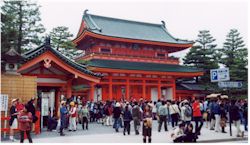
The brightly colored Heian Shrine was built in 1895 to commemorate the 1,100th anniversary of the founding of Kyoto. Unfortunately, we didn't get to see the inside of it. |
|||
|
A truly impressive sight is the 50' tall Daibutsu, the largest bronze statue of Buddha in Japan. |
|||
|
This structure should give some perspective to the size of the Daibutsu. The largest wooden structure in the world, the Daibutsuden is 161' tall, 187' long, and 164' wide. The wooden support beams inside were six feet in diameter if they were an inch. |
|||
|
Kinkakuji, or the Temple of the Golden Pavilion, is quite a sight on a sunny day. Who covers a building in gold leaf? |
|||
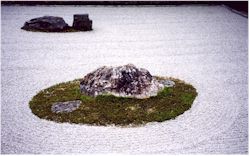
Ryoanji Temple is home to the most famous Zen Rock Garden in all of Japan. Fifteen rocks, perfectly placed to "teach us much about life". Hmm...we just didn't quite get it. |
|||
|
Mmm...udon! These thick wheat noodles were one of Seth's favorite foods. Dipped in a small cup of soy sauce, ginger, and green onions, they hit the spot. Don't miss them on your way out of Ryoanji! |
|||
|
Though Nijo Castle was not the most spectacular we saw, it was interesting to see an example of a residence castle. And the Nightengale Floors were just too cool! |
|||
|
This little garden, called Shinsen-en, just blends into the city, in a little residential side street. It struck us how much modern Japan is intermingled with its past. |
|||
